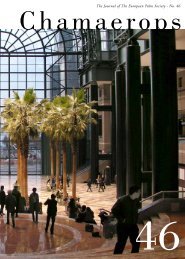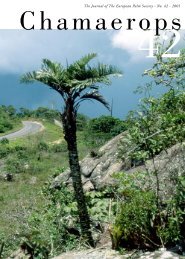Indoors the plant requires bright, indirect light.Male and female plants are required for fertileseed production. Height: 6m (20ft) Width: 2m(6ft). Conservation status: vulnerable.Rhopalostylis baueri (Kermadec Island Nikau<strong>Palm</strong>): When mature this palm has a swollencrown-shaft, upright leaves, and broad leaflets,thereby giving the appearance of a shuttlecock.When young it can be kept indoors. When olderit can be kept in a very sheltered garden where itwill require rich soil. It requires protection if thetemperature drops below the freezing point.Single plants are capable of producing fertile seed.Height: 7.5m (25ft) Width: 3m (9ft).Conservation status: rare.Rhopalostylis sapida (Nikau <strong>Palm</strong>, FeatherDuster <strong>Palm</strong>): R.sapida comes from New Zealandand the Chatham Islands, and is the mostsoutherly naturally occurring palm. It grows inwet forests, often in poorly lit situations. Plantsneed shady, moist conditions and protection fromsunlight until they are about five years old. Whenlarger, R.sapida is suitable for cultivation outdoorsin a cool temperate climate. It is best suited to acool and moist position in a sheltered gardenwhere it will require protection if the temperaturedrops below about 3°C. Single plants are capableof producing fertile seed. Height: 7.5m (25ft)Width: 3m (9ft). Conservation status:indeterminate.<strong>Palm</strong> Trees of Lake Geneva...continued from page 5at the beginning of the season, in large holesthat are deep and well drained.I went to Ticino in May in search of a newJubaea. Unfortunately, as the large specimens arerare and much in demand, I came back homewith empty hands. Finally, with the help of the<strong>Palm</strong> Centre (thank you Martin!) I received amuch wished-for Jubaea in July that Iimmediately planted it in the garden, in a large,deep hole with well draining soil. <strong>The</strong> nextautumn, my wife gave me a second Trachycarpusthat measured 180cm. Though I was anxious tohave it in the ground, I'd learned my lesson, anddecided to keep it in its pot for the first winter.For extra caution, I used rain protection andmulch on the Jubaea to help it through its firstwinter. <strong>The</strong> first Trachycarpus remained withoutprotection. Luckily, the winter of 1999-2000 wasless cold with -8°C and the Jubaea and theTrachycarpus are in good health.My last acquisitions are a Brahea armata of160cm and a Butia yatay. <strong>The</strong> Brahea was plantedin the garden at the end of March in a very sandysoil. Like others, I am surprised by its speed ofgrowth. At the end of May, it had alreadyproduced a whole leaf. I also have many youngplants: Brahea armata, Chamaerops humilis,Sabal minor, Washingtonia filifera, Jubaeachilensis, Syagrus romanzoffiana, Phoenixcanariensis, Trachycarpus fortunei, T. takil andT. latisectus. My goal is to try acclimating Phoenixtheophrasti and Parajubaea torallyi, which seemto me particularly interesting.page 12
<strong>Palm</strong>s of Tenerifeby Michael A.F. Carter, 52 Golden Avenue, West Kingston, N. East Preston, Littlehampton, West SussexBN16 1QXTenerife, one of the largest of the CanaryIslands, has a number of features of great interestto plant lovers. Situated at the centre of thearchipelago off the coast of North Africa, itssoutherly location at around 28 north and oceanicposition, guarantees year round sunshine andfrost free conditions at sea level. However, thecold Canary current driving North Atlantic seasdown from more northern climes ensures thatthe island remains cooler in the summer thancould reasonably be expected at this latitude.Consequently although a typical meantemperature in January is around 16°C/61°F, thisrises in August to 24°C/75°F only, considerablyless than much of the Mediterranean countrieslying significantly further north.Another feature is the dryness of the interiorand South and West of the island, owing to itsproximity to the Sahara and mountainous terrainin countries to the North and East, which receivelimited rainfall from the prevailing Trade Winds.Within an hour's drive it is possible to go fromlush banana plantations and vineyards to neardesert conditions therefore.Lastly is the impact of altitude. <strong>The</strong> islands,which are volcanic, have risen from the oceanfloor many millions of years ago withcorresponding numerous high peaks. In Tenerifethis feature is even more extremely demonstratedthan on the other islands, with Mt. Teide ñ abrooding volcano rising to 12,2000 feet abovesea level.Tenerife shares with its neighbours, a numberof famous native trees. Probably the most widelyplanted world-wide, ornamental for temperateand sub-tropics is Phoenix canariensis, theCanary Island Date <strong>Palm</strong> which appearseverywhere at the lower levels. This magnificentpalm of course flourishes widely, but hugespecimens can be particularly appreciated in thetown square of the market town of La Orataura,along the fertile north coast valley of the samename. In the area too can be seen the famousCanary Dragon Tree, Dracaena Draco, with aspecimen at nearby Icod, claimed to be 3000 yearsold.Further up the slopes appear forests of thebeautiful Canary Island Pine, Pinus canariensis.Indeed a must for any visitor is a drive by escortedbus taking 2 to two and a half hours from thecoast to around 7,000 feet up Mt. Teide. <strong>The</strong>journey literally commences beside African FlameTrees and Frangipani and finishes above the treeline. A trip which would normally cover 30 to40 degrees of latitude! I noted that the last partof the journey saw (presumably introduced BlueAtlantic cedars, from the Atlas mountains, takeover from the pines to the to the winter ski slope.Seeing these Cedars capable of growing at thisheight resistant to fierce winds and intensesunlight in the rarified atmosphere is trulybreathtaking.I visited the Canary Islands several times inthe 1970's. I recall in addition to the CanaryIsland palms, the ubiquitos Washingtonia, asingle large coconut , Cocus nucifera in Las <strong>Palm</strong>son Gran Canaria and a few Howea palms inNorthern Tenerife. In summer 1999, however, Iwas fortunate to return to Puerto de la Cruz, amajor resort on the northern green coast ofTenerife, for a holiday. I was intrigued to seewhether the continuing rise of the vacationindustry has triggered a more adventurous rangeof ornamental palms capable of thriving in thisbenign climate. I knew for example that in thispage 13










